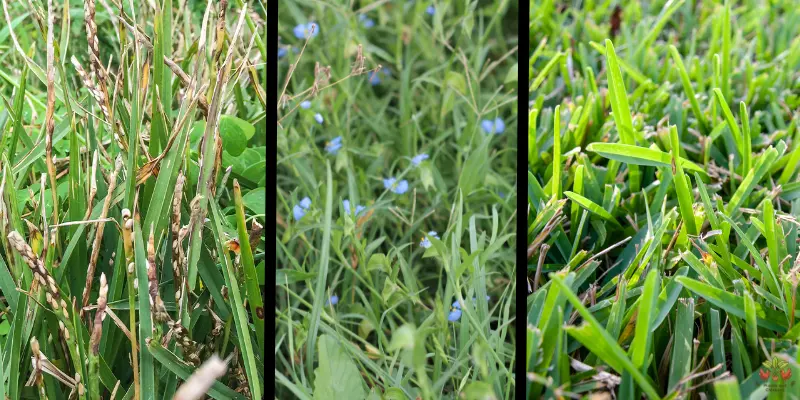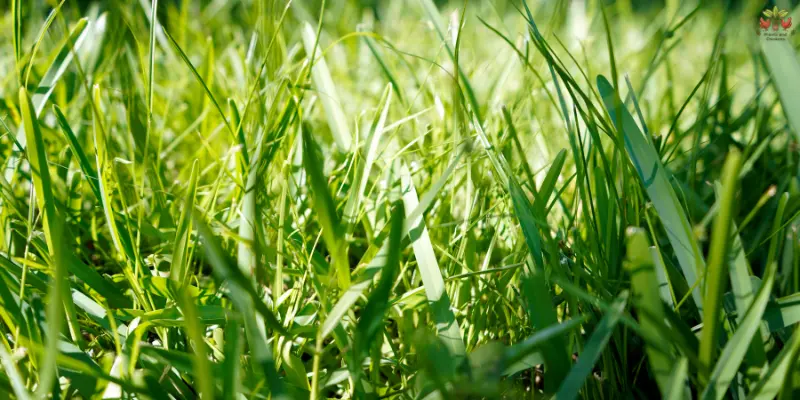To care for St. Augustine grass, water it two to three times per week, mow with sharp blades, leave at least two-thirds of its length intact, fertilize regularly, and remove weeds. Additionally, it is important to irrigate the grass properly and follow a standardized turf treatment schedule for optimal results.
For a thicker and greener lawn, follow these steps: prepare the area well, irrigate regularly, especially after installing sod for the first time, mow with sharp blades, leave at least two-thirds of the length intact, fertilize according to the needs of the grass, and remove weeds. It is recommended to water an already healthy St. Augustine lawn two to three times per week for best results.
Table of Contents
Introduction To St Augustine Grass
Discover the essential steps to care for St Augustine Grass, including proper watering, fertilization, disease prevention, and weed control. Maintain a healthy lawn with these tips for lush, green St Augustine grass.
What Is St Augustine Grass?
St Augustine grass (Stenotaphrum secundatum) is a warm-season grass that is widely used in tropical and subtropical regions, known for its lush green appearance and ability to thrive in humid environments. This popular grass variety is native to the Gulf Coast of Mexico and can be found in areas of southern Texas, Florida, and other regions with similar climates.
One of the distinct features of St Augustine grass is its dense, carpet-like growth pattern, which makes it an excellent choice for lawns and landscaping projects. It has broad, flat blades that give it a unique and attractive appearance. It is also a relatively low-maintenance grass variety, making it a popular choice for homeowners and professional landscapers alike.
Benefits And Challenges Of Growing St Augustine Grass
Growing St Augustine grass offers numerous benefits for homeowners and property managers. Here are some of the advantages of choosing St Augustine grass for your lawn:
However, growing St Augustine grass comes with its own set of challenges. Here are some factors to consider:
Understanding the benefits and challenges of growing St Augustine grass will help you make informed decisions regarding its care and maintenance, ensuring a vibrant and healthy lawn for years to come.
Basic Care For St Augustine Grass
To care for St Augustine grass, follow these tips: water deeply and infrequently (2-3 times a week), mow regularly to maintain a height of 2/3 of its length, fertilize as recommended, and control weeds with appropriate herbicides. By following these guidelines, you can keep your St Augustine grass healthy and thriving.
Watering
Proper watering is crucial for the health of St Augustine grass. The general guideline is to provide one inch of water per week, either from rainfall or irrigation. However, it’s important to adjust the watering schedule based on weather conditions to prevent over or underwatering.
Mowing
Mowing St Augustine grass at the correct height is essential for its growth and overall health. Aim to maintain a height of 3.5 to 4 inches, as this helps shade the soil and prevent weed growth. Remember to sharp blades for clean cuts and avoid cutting more than one-third of the grass’s height at a time.
Fertilizing
Fertilizing St Augustine grass is necessary to provide it with essential nutrients, promoting lush green growth. Begin fertilizing in early spring, around March or April, with a slow-release nitrogen fertilizer. Follow the instructions on the fertilizer package for application rates and frequency, as excessive fertilization can lead to thatch buildup or burn the grass.
Dealing With Yellow Grass
If you notice yellow patches or yellowing of the entire St Augustine grass lawn, it may indicate a nutrient deficiency or improper watering. Conduct a soil test to identify any nutrient deficiencies and adjust the fertilization accordingly. Inadequate watering can also cause yellowing, so ensure proper watering practices.
Controlling Diseases And Weeds
St Augustine grass is susceptible to various diseases and weeds, which can impact its health and appearance. To control diseases, maintain proper watering and ensure adequate airflow by avoiding excessive thatch buildup. For weed control, use pre-emergent and post-emergent herbicides specific to St Augustine grass. Regularly inspect the lawn for signs of diseases or weeds and take necessary action promptly.

Advanced Care Tips For St Augustine Grass
Discover advanced care tips for maintaining and improving the health of your St Augustine grass. Learn proper watering, fertilizing, disease prevention, and weed control techniques to keep your lawn thick and vibrant.
St Augustine grass, with its lush green appearance and dense growth, is a popular choice for lawns in warm regions. While basic care practices such as regular mowing and watering are essential, there are advanced care tips that can help you achieve even thicker and greener grass. In this section, we will discuss key areas of advanced care for your St Augustine grass, including thickening and greening the grass, proper irrigation techniques, yearly maintenance, and choosing the best fertilizer.
Thickening And Greening The Grass
To achieve a thick and vibrant St Augustine grass, there are a few steps you can take:
Proper Irrigation
Proper irrigation is crucial to maintain the health and appearance of St Augustine grass. Here are some guidelines:
- Water deeply and infrequently: Instead of frequent shallow watering, it’s best to water deeply and less often. This encourages the grass roots to grow deeper into the soil, making them more resilient to drought and stress.
- Avoid overwatering: While St Augustine grass requires regular watering, overwatering can lead to shallow root growth and increased susceptibility to diseases and pests. Monitor the moisture levels of your lawn and adjust your irrigation schedule accordingly.
- Water in the early morning: Watering your lawn in the early morning allows the grass blades to dry before nighttime, reducing the risk of fungal diseases. It’s also the time when evaporation is at its lowest, ensuring maximum water absorption.
- Consider installing an irrigation system: An automated irrigation system can ensure consistent and efficient watering of your St Augustine grass. Consult with a professional to determine the best irrigation system for your lawn.
Yearly Maintenance
In addition to regular care practices, St Augustine grass benefits from specific yearly maintenance tasks. These include:
- Core aeration: Performing core aeration annually helps alleviate soil compaction and improves air and water circulation in the root zone.
- Overseeding: Overseeding your St Augustine grass every year can help fill in bare spots and maintain a thick and healthy lawn.
- Weed control: Regularly inspect your lawn for weeds and apply herbicides accordingly. Look for herbicides specifically labeled for use with St Augustine grass.
- Pest control: Keep an eye out for common pests that can damage St Augustine grass, such as chinch bugs and armyworms. Use appropriate insecticides if necessary.
Choosing The Best Fertilizer
When it comes to fertilizing St Augustine grass, selecting the right product is essential. Consider the following factors:
- Nitrogen content: St Augustine grass thrives with a nitrogen-rich fertilizer. Look for a product with a higher nitrogen content in the NPK ratio, as nitrogen promotes lush green growth.
- Schedule and application rate: Follow the recommended schedule and application rate specified on the fertilizer packaging. Applying too much or too little can lead to nutrient deficiencies or burn the grass.
- Slow-release vs. quick-release fertilizers: Slow-release fertilizers gradually release nutrients over time, providing longer-lasting nourishment. Quick-release fertilizers offer immediate results but may require more frequent applications.
- Micronutrients: Consider a fertilizer that contains essential micronutrients for St Augustine grass, such as iron. These micronutrients can help improve the overall color and health of your lawn.
Frequently Asked Questions On How To Care For St Augustine Grass
How Do You Keep St. Augustine Grass Healthy?
To keep St. Augustine grass healthy, follow these steps:
Regularly water your lawn,
mow it to maintain a two-thirds length, fertilize it, and remove weeds.
Irrigate your lawn two to three times per week for optimal results, especially for an already healthy lawn.
What Is The Best Thing To Put On St. Augustine Grass?
The best thing to put on St. Augustine grass is a fertilizer specific to St. Augustine grass, such as Milorganite Organic Nitrogen Fe or Scotts Southern Lawn Food. This will provide the necessary nutrients for the grass to thrive and stay healthy.
How Do I Make My St. Augustine Grass Thicker And Greener?
To make your St. Augustine grass thicker and greener, follow these steps:
1. Prepare the area before planting or sodding.
2. Ensure proper irrigation, especially for newly installed sod.
3. Mow regularly, leaving at least two-thirds of the grass length intact and using sharp blades.
4. Apply fertilizer according to recommended guidelines.
5. Control weeds to prevent competition for nutrients.
How Often Should St. Augustine Grass Be Watered?
St. Augustine grass should be watered two to three times per week for an already healthy lawn. Proper irrigation and following a standardized Turf Treatment Schedule will help maintain optimal health for the grass.
Conclusion
Taking care of your St Augustine grass is essential for maintaining a healthy and vibrant lawn. By following the tips and guidelines provided in this blog post, you can ensure that your grass remains thick, green, and free from disease and weeds.
Remember to water and fertilize regularly, mow with sharp blades, and address any issues promptly. With proper care, your St Augustine grass will thrive and provide you with a beautiful and inviting outdoor space.


![Terrifying Trend: Why Do Roosters Chase Humans? [2024]](https://plantsandchickens.com/wp-content/uploads/2024/02/why-do-roosters-chase-humans-4.webp)


Leave a Reply